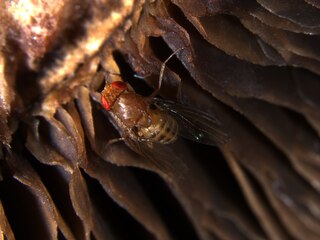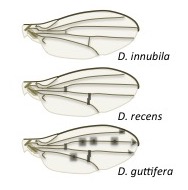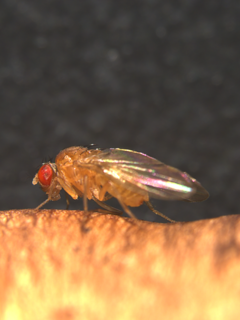
Drosophila is a genus of flies, belonging to the family Drosophilidae, whose members are often called "small fruit flies" or pomace flies, vinegar flies, or wine flies, a reference to the characteristic of many species to linger around overripe or rotting fruit. They should not be confused with the Tephritidae, a related family, which are also called fruit flies ; tephritids feed primarily on unripe or ripe fruit, with many species being regarded as destructive agricultural pests, especially the Mediterranean fruit fly.

The immigrans-tripunctata radiation is a speciose lineage of Drosophila flies, including over 300 species. The immigrans-tripunctata radiation is a sister lineage to most other members of the subgenus Drosophila. A number of species have had their genomes or transcriptomes sequenced for evolutionary studies using Drosophila.

Drosophila is a paraphyletic subgenus of the genus Drosophila, a classification of fruit flies. This subgenus was first described by Alfred Sturtevant in 1939. Members of the subgenus Drosophila can be distinguished from other Drosophilid species by breaks in the pigmentation along the dorsal section of their abdomen.

.
Drosophila tripunctata is a species of vinegar fly in the Immigrans-tripunctata radiation of the subgenus Drosophila.

Drosophila guttifera is a species of vinegar fly in the Drosophila quinaria species group.

Drosophila immigrans is a species of vinegar fly in the family Drosophilidae. Drosophila immigrans is a member of the Immigrans-tripunctata radiation of the subgenus Drosophila. It is related to the Drosophila quinaria and Drosophila testacea species groups, and the fellow Immigrans species group member Drosophila albomicans. Drosophila immigrans has been used in evolutionary studies to understand how viruses evolve with their hosts.
Drosophila quinaria is a species of fruit fly in the Drosophila quinaria species group. Most Quinaria group species feed largely on mushrooms. However D. quinaria instead eats decaying vegetative matter, a trait it evolved independently.
Drosophila deflecta is a species of fruit fly in the Drosophila quinaria species group.

The Drosophila testacea species group belongs to the Immigrans-tripunctata radiation of the subgenus Drosophila, and contains 4 species: Drosophila putrida, Drosophila neotestacea, Drosophila testacea, and Drosophila orientacea. Testacea species are specialist mushroom-feeding flies, and can metabolize toxic compounds in Amanita mushrooms. The Testacea species group is studied for its specialist ecology, population genetics, and bacterial endosymbionts. The North American species Drosophila neotestacea is perhaps the best-studied of the group for its interactions with parasitic wasps and nematodes, bacterial endosymbionts, and trypanosomatid parasites. Of note, selfish X chromosomes have been discovered in three of the four Testacea group species.
Drosophila bizonata is a species of fruit fly in the Drosophila bizonata species group in the Immigrans-tripunctata radiation of the Drosophila subgenus. Drosophila bizonata is found in Japan. D. bizonata breeds and feeds exclusively on mushrooms, and has a high tolerance for ibotenic acid, a toxic compound found in Amanita mushrooms.

The Drosophila quinaria species group is a speciose lineage of mushroom-feeding flies studied for their specialist ecology, their parasites, population genetics, and the evolution of immune systems. Quinaria species are part of the Drosophila subgenus.
The Drosophila cardini species group belongs to the subgenus Drosophila of vinegar flies in the Immigrans-tripunctata radiation of the subgenus Drosophila. The closest relatives of Cardini species include Drosophila bizonata, Drosophila quinaria, and Drosophila testacea species groups, comprising mushroom-feeding flies. Cardini group species likely derived their more general feeding ecology from a mushroom-feeding ancestor, an evolutionary transition in feeding similar to Drosophila quinaria.

Mushroom-feeding Drosophila are a subset of Drosophila flies that have highly specific mushroom-breeding ecologies. Often these flies can tolerate toxic compounds from Amanita mushrooms.

Drosophila innubila is a species of vinegar fly restricted to high-elevation woodlands in the mountains of the southern USA and Mexico, which it likely colonized during the last glacial period. Drosophila innubila is a kind of mushroom-breeding Drosophila, and member of the Drosophila quinaria species group. Drosophila innubila is best known for its association with a strain of male-killing Wolbachia bacteria. These bacteria are parasitic, as they drain resources from the host and cause half the infected female's eggs to abort. However Wolbachia may offer benefits to the fly's fitness in certain circumstances. The D. innubila genome was sequenced in 2019.
Jaenimonas drosophilae is a trypanosomatid parasite of mushroom-feeding flies, first characterized in Drosophila neotestacea and Drosophila falleni. Jaenimonas takes up residence in the gut of the fly, and infection leads to reduced fecundity of its fly host. The species is named for John Jaenike, a prominent ecologist and evolutionary biologist whose work on mushroom-feeding flies laid the foundation for studies on mycophagous Drosophila.
Jaenimonas is a genus of trypanosomatid parasite that infects mushroom-feeding Drosophila, similar to Crithidia parasites of Bumblebees. Jaenimonas drosophilae is the sole representative of this genus. The genus is named in honor of John Jaenike, a prominent ecologist and evolutionary biologist whose work on mushroom-feeding flies laid the foundation for studies on mycophagous Drosophila. Jaenike was also an early proponent of the Red Queen hypothesis.

Drosophila phalerata is a species of mushroom-feeding fruit fly in the Drosophila quinaria species group. The genome of D. phalerata was sequenced in 2019 as part of a study on the evolution of immune systems, but was not assembled de novo.
Drosophila albomicans is a species of vinegar fly in the family Drosophilidae. Drosophila albomicans is a member of the Immigrans-tripunctata radiation of the subgenus Drosophila. The D. albomicans genome was first sequenced in 2012 to study the evolution of novel sex chromosomes, a characteristic this species is best known for. One commonly accepted definition of the biological species concept is that individuals or populations are members of different species if they are incapable of successful interbreeding. While D. albomicans and Drosophila nasuta are commonly referred to as distinct species, there appears to be little to no sexual isolation between these two Drosophila species. Instead, behavioural differences appear to reproductively isolate these two species.

The Drosophila Immigrans species group is a polyphyletic and speciose lineage of Drosophila flies, including over 100 species. Immigrans species belong to the Immigrans-tripunctata radiation of the subgenus Drosophila. Well-described species include Drosophila immigrans, and the sister species Drosophila albomicans and Drosophila nasuta. The genome of D. albomicans was sequenced in 2012 in an effort to characterize novel sex chromosome development in D. albomicans. Immigrans group species are related to mushroom-breeding Drosophila of the Quinaria and Testacea species groups.







